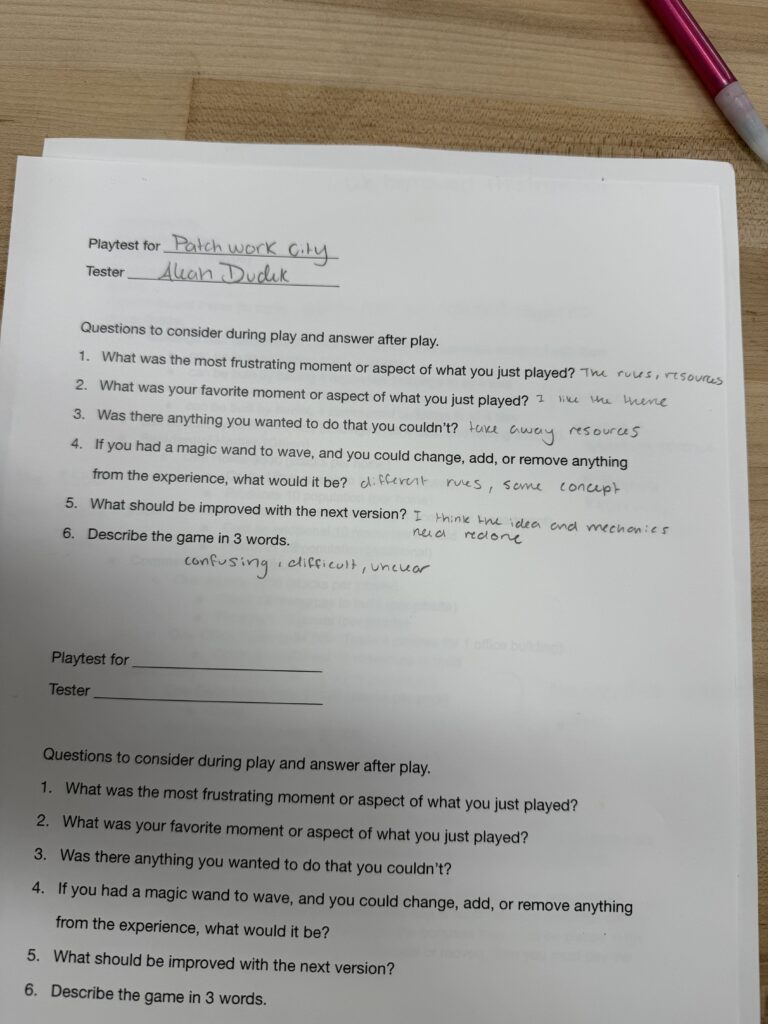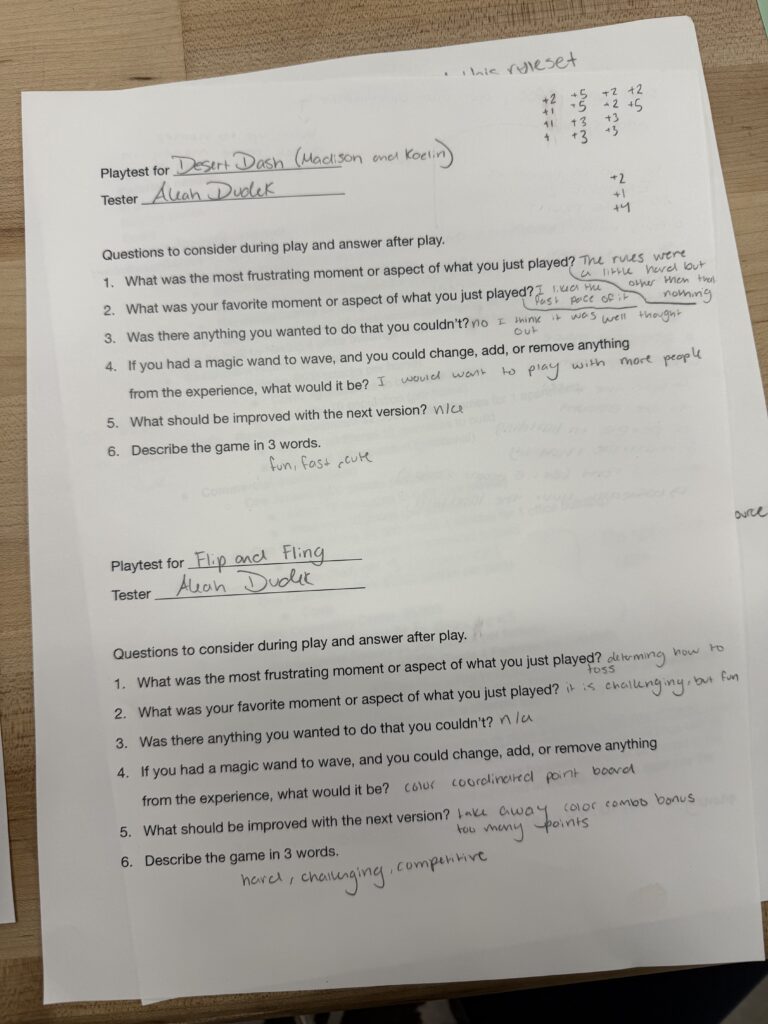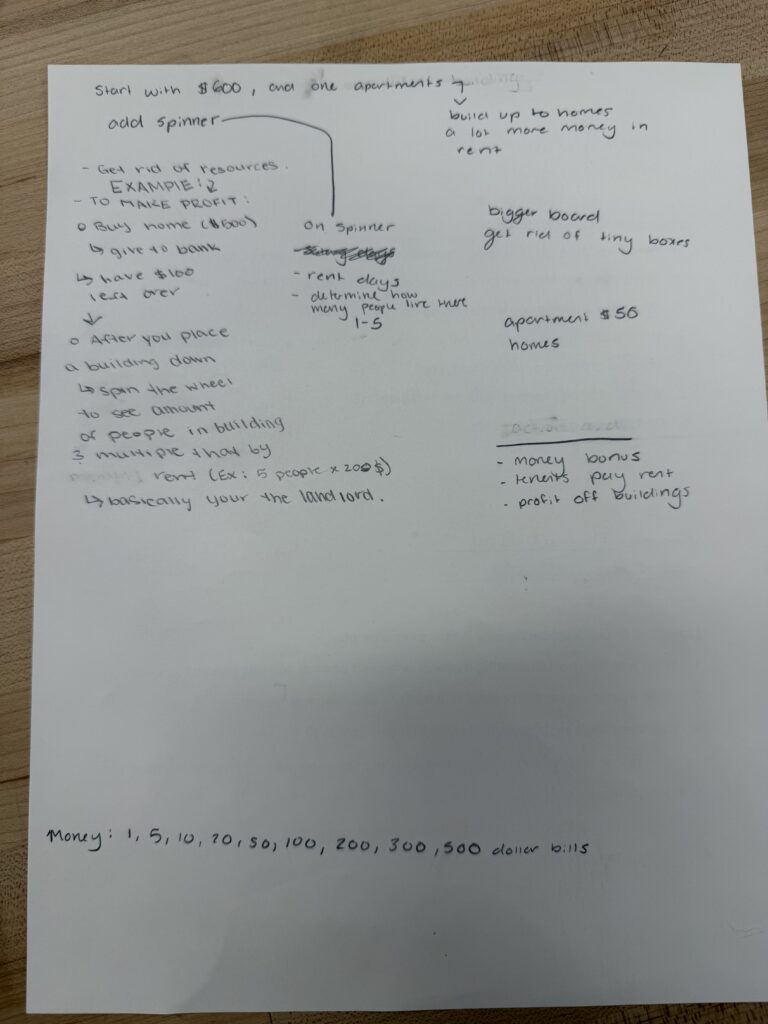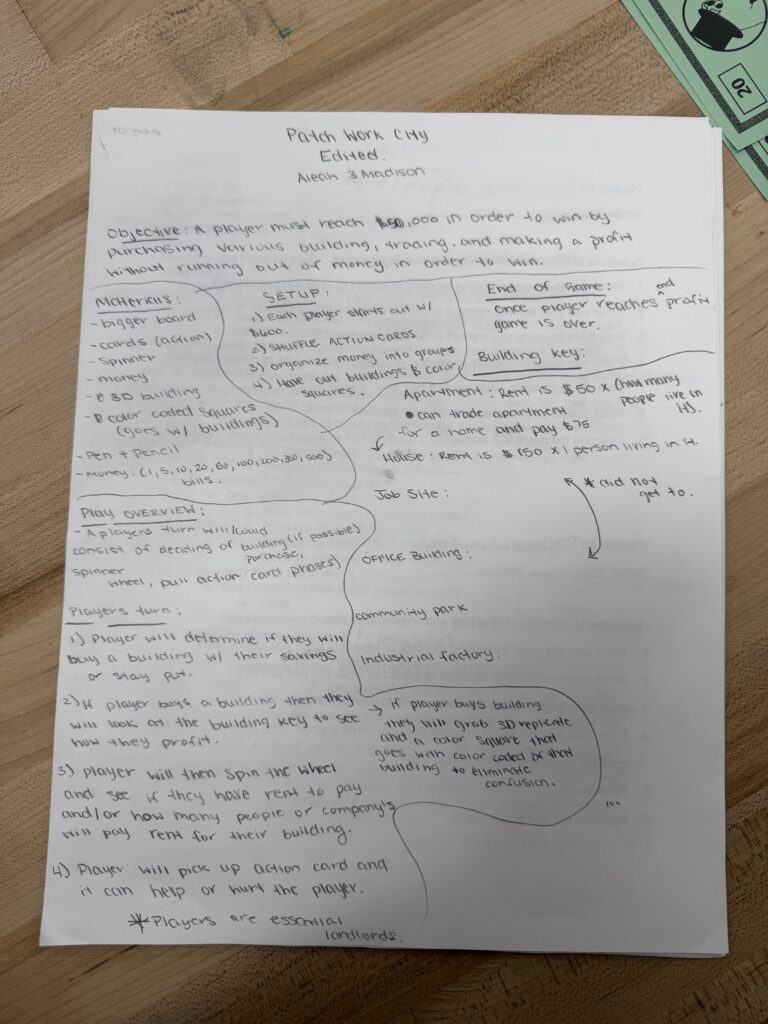




design courses, syllabi, schedules, resources and policies
Aleah Dudek
Aleah Dudek
Splendor
Was it fun? Yes I enjoyed it.
What were the player interactions? yes there are aspects that get competitive.
How long did it take to learn? It took us a lot shorter than other games maybe about 10 minutes.
What was the most frustrating moment or aspect of what you just played? I didn’t really find anything frustrating.
What was your favorite moment or aspect of what you just played? I liked the different moves and you n ever know what card you are going to go for.
Was there anything you wanted to do that you couldn’t? I wish there was cards where you could steal other peoples cards.
If you had a magic wand to wave, and you could change, add, or remove anything
from the experience, what would it be? I wish there was more action cards.
Is this a game you would play again? Yes _____ No ______ Why I enjoyed it I Liked the strategy in it too.
Analyze the game using the 3 act structure.
Act 1: The focus is on collecting gem tokens to afford the cheapest development cards. Most players just grab what’s available; strategy is light, and everyone’s building their “engine” from scratch. Victory points aren’t usually scored yet, this stage is about laying groundwork.
Act 2: Players have cards that permanently give gems, making each future turn stronger. Players start racing for medium-value cards, noble tiles become reachable, and blocking moves emerge. Some players aim for nobles, others for big-point high-cost cards, creating diverging paths to victory.
Act 3: The board shrinks in options—players fight for the last few cards that can push them over 15 points. Every gem token and reserved card matters; timing is crucial since the first to 15 triggers the end. Victory comes from a combination of planning (engine + nobles) and tactical plays in the last few turns.
What are the collaborative and or competitive aspects of the game? The collaborative part I think would be not hogging the tokens I guess and the competitive could be the ability to steal a card someone wanted to eventually take.
What is the game’s metaphor and which of the game’s mechanics standout?
The metaphor : The gems = raw resources of wealth and beauty.
The development cards = mines, transportation, artisans → infrastructure for growing power.
The nobles = recognition and patronage from high society once your wealth reaches a certain level.
The mechanic: Players collect gem tokens .Use gems to purchase development cards, which give permanent gem bonuses .Those bonuses make it easier to buy more expensive, higher-point cards.Noble tiles reward players for meeting certain card thresholds
Aleah Dudek
Compass: is a puzzle-solving game in which the players’ avatars collaborate to reassemble a broken communication networkby placing signal towers, routing energy beams, and coordinating timing in real time.
Read Me: is a communication challenge game in which players work together to pass a secret message across the group by using only gestures, sounds, or objects (no talking) to transmit clues before time runs out.
Tip Toe: is a stealth-vs-guard game in which teams of players try to steal a hidden object by sneaking past “guards” without getting tagged — whichever team extracts the object first wins.
Campus Conspiracy: is a team-based mystery game in which players work together to solve a strange campus incident by collecting clues, interrogating characters (played by volunteers or pre-written prompts), and piecing together evidence before rival teams solve it first.
Human Pretzel: is a physical comedy and teamwork game in which teams of players race to untangle themselves into a perfect formation by following weird, escalating prompts from a “Pretzel Master” without ever letting go of each other’s hands.
ALEAH DUDEK
Argument :
Was it fun? It was fun I think it would be more fun playing competitively.
What were the player interactions? Yes almost every turn.
How long did it take to learn? Only a few minutes I liked how easy it was to understand.
What was the most frustrating moment or aspect of what you just played? I didn’t find the game frustrating at all , but I can see how it would be if it was the competitive version.
What was your favorite moment or aspect of what you just played? I liked the different match making and the different ways you have to move the pieces.
Was there anything you wanted to do that you couldn’t? No
If you had a magic wand to wave, and you could change, add, or remove anything
from the experience, what would it be? I wouldn’t change anything I think it’s a nice simple game that could be played over and over again.
Is this a game you would play again? Yes _____ No ______ Why I think it was fun, can be relaxing , but also competitive.
Analyze the game using the 3 act structure.
Act 1 : The set up was to set up your pieces either in order or random and move them accordingly to how the certain symbols moves along the board and try to get the 3 stacks in order to collect points.
Act 2: The rising action could be to make the matches and collect more and more in order to win or screw people over potentially.
Act 3 : If you wipe all the pieces off the board or have the most stacks you win the game or everyone wins the game if playing the collaborative version.
What are the collaborative and or competitive aspects of the game? The collaborative aspects is helping each other out moving pieces to one another to get stacks and wipe more pieces iff the board. The competitive aspect is making your way over to other peoples pieces to steal their pieces in order to give yourself more stacks.
What is the game’s metaphor and which of the game’s mechanics standout?
I would think the games metaphor is rock paper scissors because some pieces over power other pieces to make stacks and collect stacks for yourself or one another. The mechanics I would say is also Rock paper scissor because we used that to determine who went first. Also the way the pieces moved in order to get around the board and the colors of the pieces.
ALEAH DUDEK
Forbidden Island:
Was it fun? It was alright the mechanics were kind of boring , but the theming was pretty.
What were the player interactions? Yes we had to collaborate the entire game almost, but we could make personal decisions.
How long did it take to learn? Not long like 20 minutes.
What was the most frustrating moment or aspect of what you just played? I wasn’t really frustrated, I guess the only thing is is that it was a little too easy to beat.
What was your favorite moment or aspect of what you just played? I liked the theming and the suspense of it.
Was there anything you wanted to do that you couldn’t? Not really, but I wish it was trickier.
If you had a magic wand to wave, and you could change, add, or remove anything
from the experience, what would it be? I would add more cards such as to deflood or more actions to move.
Is this a game you would play again? Yes _____ No ______ Why No it was kind of boring it is definitely a one and down game.
Analyze the game using the 3 act structure.
Act 1 : The board is laid out in different locations making it more adventurous, the tiles representing different parts of the island. The characters choose their abilities and their “powers” throughout the game. The objective is to save the island from sinking while collecting treasures. You are in danger of pulling sinking cards destroying the island while trying to save it.
Act 2: More tiles flood and disappear, making the map shrink. The water level meter may rise from bad flood card draws. Key tiles needed for treasures may flood, threatening to end the game early. Players have to sacrifice actions and resources to keep them intact. Players must coordinate their moves carefully.
Act 3: The last treasures are collected, the water level is dangerously high, and players make their desperate dash to the helicopter pad. The story will end in a win or defeat.
What are the collaborative and or competitive aspects of the game? We had to collaborate to collect the treasures and the competitiveness was pulling the sinking cards.
What is the game’s metaphor and which of the game’s mechanics standout? The games metaphor is risk and reward I feel because the team has to collaborate in order to save the island, but as you pull cards it can get really risky to the race to save the island from flooding. The mechanics are the flooding and sinking tiles limiting where players can go. The water level meter can dictate how in danger you are in. The treasure cards can help lead you to victory. Role powers can help collaboration or avoid the sinking tiles.
Aleah Dudek